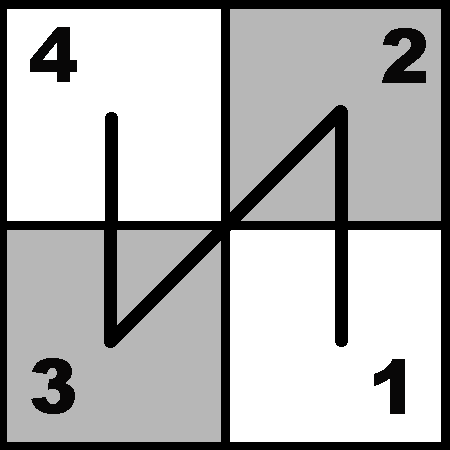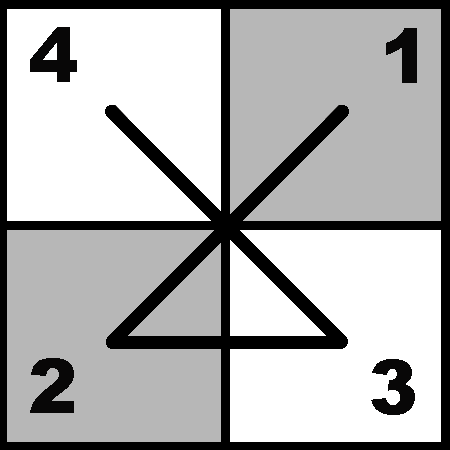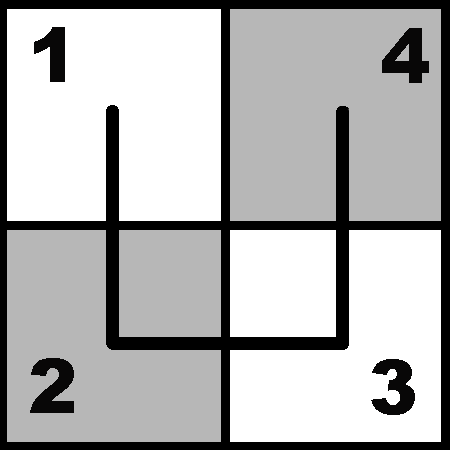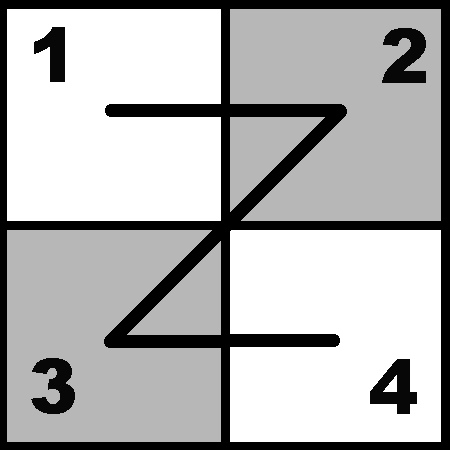Star Trek: The Next Generation
Comprehensive Storyform for the Series Finale -- "All Good Things"
The following analysis reveals a comprehensive look at the Storyform for Star Trek: The Next Generation. Unlike most of the analysis found here—which simply lists the unique individual story appreciations—this in-depth study details the actual encoding for each structural item. This also means it has been incorporated into the Dramatica Story Expert application itself as an easily referenced contextual example.
Story Dynamics
8 of the 12 essential questions
- Change
- Main Character Resolve
Picard is thrown willy-nilly through time, trying to understand why. At first he is at the whim of the time-shifting. He then realizes that he can use the time-shifting to his advantage in solving the problem of the paradox. He is therefore able to turn the chaos into order.
- Stop
- Main Character Growth
Picard must stop looking at the universe and the time-space continuum in a linear fashion if he is to recognize the advantage of his time-shifting and solve the meaning of the paradox. At the scene of the “Trial,” Picard says to Q that seven years earlier Q had already tried him and his crew. Q responded flippantly that Picard always looks at time in such a “linear” fashion.
- Do-er
- Main Character Approach
In the beginning, even though Picard is not exactly sure why he is time-shifting and there is a possibility that he (in the future) is suffering from the mental disorder, he urgently seeks helps from his friends and colleagues to figure out what is going on.
- Male
- Main Character Mental Sex
Picard chooses to “CAUSE AND EFFECT” by solving the problem of the paradox and saving mankind.
- Action
- Story Driver
Picard is thrown back and forth through time and must therefore come up with a plan to deal with it.
- Optionlock
- Story Limit
Picard only has one option to save mankind—solve the meaning of the “paradox” and figure out a way to destroy the spatial anomaly.
- Success
- Story Outcome
Picard solves the “paradox” of the spatial anomaly and closes the anti-time eruption. Therefore, the destruction of mankind is prevented.
- Good
- Story Judgment
Q congratulates Picard for being able to expand his mind, thereby saving mankind . . . again. Also, Picard is at peace with the fact that mankind is saved and will be open to new possibilities of existence.
Overall Story Throughline
""Paradox of the Spatial Anamoly""
- Physics
- Overall Story Throughline
Picard and the crew are searching for a meaning to Picard’s time-shifting and its relation to the spatial anomaly in the Devron System.
- Understanding
- Overall Story Concern
Everyone is concerned with understanding the meaning of the spatial anomaly as well as Picard’s time-shifting. The past Enterprise crew is also concerned with understanding their new captain’s erratic orders.
- Interpretation
- Overall Story Issue
The respective crews and time-shifting “Picards” must correctly interpret Q’s intentions. Everyone must also correctly interpret the paradox of the spatial anomaly.
- Senses
- Overall Story Counterpoint
- Overall Story Thematic Conflict
Interpretation vs.Senses - Chaos
- Overall Story Problem
Picard’s time-shifting is inherently chaotic because it happens without warning and at first it appears to be happening without purpose.
- Order
- Overall Story Solution
Picard must make some order out of his chaotic time-shifting. Once he realizes that he can use the time-shifting to his advantage, he does so to solve the problem of the paradox.
- Inequity
- Overall Story Symptom
The characters (particularly Picard) are concerned with the inequity that exists in the various time periods. For example: the anomaly is larger in the past and for a while it doesn’t even appear in the future; Picard has a mental disorder in the future; Picard is concerned with the fact that the past is different than how he remembered it (i.e. the red alert he calls at the boarding ceremony).
- Equity
- Overall Story Response
In each time period, Picard attempts to get the Enterprise to go to the Devron System and find the spatial anomaly. He even does this in the past, where it will mean changing the events from how he remembered them (i.e. eventually abandoning the mission to Far Point station to go to the Devron System). Essentially, he’s trying to make all the time periods “equal” to one another.
- Senses
- Overall Story Catalyst
Picard is sensing that he is time-shifting. That is what gets the ball rolling. The more he time-shifts, the more information he gathers to destroy the anomaly.
- Circumstances
- Overall Story Inhibitor
Picard’s mental disorder in the future, coupled with the changes in the Klingon Empire, impedes his ability to convince his future colleagues to help him. The current Enterprise’s relationship with Q makes it difficult for them to trust him, thereby, possibly impeding the objective story progress.
- Learning
- Overall Story Benchmark
In the various time periods, Picard learns more about the anomaly and he learns more about ways of stopping it. He shares this information with his crew mates so they will learn as well.
Additional Overall Story Information →
Main Character Throughline
Jean-Luc Picard — Starship Captain
- Universe
- Main Character Throughline
Each time-shift represents a different situation for Picard that he must deal with in a different manner based upon what his colleagues at the time know and understand of him.
- Past
- Main Character Concern
Picard is concerned that the past (the time just before he boarded the Enterprise for the first time) is evolving differently than what he remembered. Furthermore, the “destruction” of mankind takes place in the past when the spatial anomaly prevents the start of life of Earth over 3 billion years ago.
- Fate
- Main Character Issue
Picard is faced with the fate of mankind in his hands. According to Q, he is fated to be the cause for mankind’s destruction. He also must face the bleak future of separated friends and a mental disorder.
- Destiny
- Main Character Counterpoint
- Main Character Thematic Conflict
Fate vs.Destiny - Chaos
- Main Character Problem
Picard is in a chaotic state because of his random time-shifting. He must overcome this chaos somehow.
- Order
- Main Character Solution
Once Picard realizes there is a reason for his time-shifting, he can use it aid him in solving the paradox and closing the anti-time eruption. For example, when he realizes that the “Enterprises” must end the inverse dekion scan, he informs the crew in each time period. Also, he uses the time shifting to his advantage by taking advanced knowledge in the future periods and applying it to the past periods where it had not yet been conceived.
- Thought
- Main Character Symptom
Picard focuses on considering what Q has told him in the “Trial,” regarding his (Picard’s) role in the destruction of mankind.
- Knowledge
- Main Character Response
Driven by the thought of destroying mankind, Picard tries to come up with the knowledge of how and why it is possible that he could/would do such a thing.
- Prediction
- Main Character Unique Ability
Picard knows what happens in the future because of his time-shifting. This is the only way he is able to solve the meaning of the paradox.
- Suspicion
- Main Character Critical Flaw
Because Picard is suspicious of Q and his antics (based upon previous encounters) he may not take to heart what Q has told him regarding time, space, mankind’s destruction, etc.
- Present
- Main Character Benchmark
Picard knows that the only “correct” time period is the present. The future and past periods which he visits through the time-shifting are warped due to presence of the anomaly as well as Q’s “trial.” If he saves mankind, he’ll realize it when he is “returned” to the present by Q.
- Main Character Description
A debonair, bald Frenchman with an English accent. Captain of the U.S.S. Enterprise 1701-D. He is the consummate diplomat and one of Starfleet’s greatest heroes.
Additional Main Character Information →
Influence Character Throughline
Q — Omnipotent Being
- Mind
- Influence Character Throughline
Q believes that he is superior to mankind in every way.
- Memory
- Influence Character Concern
Q is concerned with the first trial through which he put Picard seven years ago and how Picard/mankind has grown since that trial. He is also particularly concerned with how mankind has evolved throughout the years.
- Truth
- Influence Character Issue
Even though the information Q gives Picard regarding the destruction of mankind seems impossible to be true, it is indeed true (in one possible timeline). It even seems impossible to the audience that Picard could be the reason behind mankind’s destruction. Q proves he is correct when he takes Picard back to the beginnings of life on Earth and shows that due to the spatial anomaly, the amino acids don’t combine to form the basics of life. Ergo, mankind is “destroyed” by never being created in the first place.
- Falsehood
- Influence Character Counterpoint
- Influence Character Thematic Conflict
Truth vs.Falsehood - Speculation
- Influence Character Problem
Q is driven by the speculation of what mankind can become if they open up their mental horizons. He is also driven by the possibility that Picard can solve the problem of the paradox. The other members of the Q Continuum are not as confident in Picard’s ability.
- Projection
- Influence Character Solution
Q uses his past dealings with Picard to alert him to what is actually going on. This is how Picard knows to look for Q right before going to Far Point Station in the past. This will increase the probability of Picard solving the problem.
- Inequity
- Influence Character Symptom
Q focuses on the inequity between the Q and mankind and how mankind cannot look at different levels of existence in the same way as the Q.
- Equity
- Influence Character Response
Q attempts to elevate Picard’s level of thinking so that it is more “equal” to his own (regarding the various possibilities of existence).
- Evidence
- Influence Character Unique Ability
Q provides Picard with all the evidence necessary to solve the problem. He does this through the time-shifting.
- Interdiction
- Influence Character Critical Flaw
In essence, through Picard’s time-shifting, Q is altering the future in such a way that mankind will be destroyed. Since it appears that deep down inside Q wants to save mankind (in his own demented way), Q’s interdiction undermines his method to help Picard.
- Conscious
- Influence Character Benchmark
Q considers the ramifications that may occur if Picard doesn’t solve the paradox.
- Influence Character Description
An omnipotent being who has a fascination with humankind—particularly Jean-Luc. He constantly puts the crew of the Enterprise through tests.
More Influence Character Information →
Relationship Story Throughline
""Expanding Mental Horizons""
- Psychology
- Relationship Story Throughline
Q’s whole point for testing mankind (via Picard) is to see if he can look at and consider all the different possibilities of existence. He also wants Picard to stop looking at the time-space continuum in a linear fashion.
- Conceptualizing
- Relationship Story Concern
Picard is attempting to conceptualize a method to solve the problem of the paradox (which involves collapsing the spatial anomaly). However, Q’s only help is the time-shifting, which Picard doesn’t realize is a form of help until later.
- Circumstances
- Relationship Story Issue
Because of the previous relationships that Picard and Q have had, emotionally, it is very difficult for Picard to trust Q.
- Situation
- Relationship Story Counterpoint
- Relationship Story Thematic Conflict
Circumstances vs.Situation - Self-Aware
- Relationship Story Problem
Q is concerned that Picard may be too self-aware to open his mind up to new possibilities of existence.
- Aware
- Relationship Story Solution
Q must get Picard to be aware of all the other complexities of existence to which Picard has been blind because of his focus on mankind’s progress. Even when all the commotion is over, Picard is concerned with whether or not he’s saved mankind. Q comments on this at the end of the story.
- Inequity
- Relationship Story Symptom
There is an inherent inequity between Q (an omnipotent being) and Picard (a mortal).
- Equity
- Relationship Story Response
Q essentially tries to elevate Picard’s level of thinking to his own in order to solve the problem of the paradox.
- Situation
- Relationship Story Catalyst
Each time-shift represents a different situation for Picard that he must deal with in a different manner based upon what his colleagues at the time know and understand of him. The time-shifting moves the subjective story forward because 1) Q is responsible for it, and 2) Picard realizes that Q has created the time-shifts to aid Picard in solving the problem of the paradox.
- Interpretation
- Relationship Story Inhibitor
Picard’s incorrect interpretations of Q’s intentions could impede the subjective story’s progress. Picard at first sees the time-shifting (admittedly caused by Q) as a nuisance and serious problem. He later realizes that it’s Q’s way of actually helping him.
- Conceiving
- Relationship Story Benchmark
As Picard conceives of ways in which Q may be telling him the truth, Q congratulates him and eggs him on. Also, in the trial, the relationship between Q and Picard grows as Picard comes up with yes/no questions to ask of Q.
Additional Relationship Story Information →
Additional Story Points
Key Structural Appreciations
- Understanding
- Overall Story Goal
All the characters are attempting to understand the significance of the spatial anomaly in the Devron System.
- Conceptualizing
- Overall Story Consequence
If they fail to achieve the goal (understanding the paradox), they will not be able to conceptualize a way to reverse the anti-time “explosion” caused by the spatial anomaly.
- Memory
- Overall Story Cost
In essence, Picard is reliving old memories as he time-shifts. Picard is also reliving the memory of the Trial by Q. The future Worf and Riker relive old, painful memories regarding their failed friendship and the death of Deanna Troi. The future Beverly relives the memories of being married to Jean-Luc.
- Past
- Overall Story Dividend
Essentially, since the “future” is so bleak for everyone (i.e. Worf and Riker’s broken friendship, parted friends, etc.) the crew members can correct their future problems in the past (i.e. Riker not letting Worf’s relationship with Deanna ruin their friendship). The biggest dividend in the past is the fact that since the paradox is solved, the anti-time spatial anomaly is destroyed and the amino acids combine to form the beginnings of life on earth over 3 billion years ago.
- Learning
- Overall Story Requirements
The past crew members must learn about scientific solutions to problems that would not have been considered until their future. Everyone must also learn about the effects of anti-time and the spatial anomaly.
- Conceiving
- Overall Story Prerequisites
Picard and his mates must conceive the idea of the anti-time paradox. Without doing that, they would not know to attempt to end the anti-time eruption.
- Conscious
- Overall Story Preconditions
Picard and the crew must consider that Q is actually trying to help them solve the paradox riddle. Picard must also grapple with the consideration that he is the cause of mankind’s destruction.
- Present
- Overall Story Forewarnings
It is in the present day Enterprise that the effects of the spatial anomaly are felt (i.e. Alissa losing her baby, Geordi regaining his eyesight, Beverly’s discovery that everyone is degenerating to a basic molecular form). This is a forewarning that the spatial anomaly is destroying mankind.
Plot Progression
Dynamic Act Appreciations
Overall Story
- Learning
- Overall Story Signpost 1
Everyone is concerned with learning why Picard is time-shifting (if he truly is). The past Enterprise is concerned with learning about their new captain’s motives.
- Doing
- Overall Story Signpost 2
In Act 2, the future crew members are concerned with brainstorming ways in which they can reach the Devron System and solve the mystery of Picard’s time shifting. In the present, the crew members are concerned with reaching the Devron System. In the past, the crew is concerned with reaching Far Point Station.
- Obtaining
- Overall Story Signpost 3
The future Picard and colleagues are concerned with obtaining a ship to reach the Devron System. The present crew is concerned with obtaining passage into the neutral zone.
- Understanding
- Overall Story Signpost 4
Everyone is concerned with understanding the physical and scientific attributes of the spatial anomaly so that they can find a way to collapse it.
Main Character
- Progress
- Main Character Signpost 1
- Future
- Main Character Signpost 2
- Present
- Main Character Signpost 3
- Past
- Main Character Signpost 4
Influence Character
- Memory
- Influence Character Signpost 1
- Subconscious
- Influence Character Signpost 2
- Conscious
- Influence Character Signpost 3
- Preconscious
- Influence Character Signpost 4
Relationship Story
- Conceptualizing
- Relationship Story Signpost 1
Picard suspects that Q is at the bottom of the time-shifting, but he must conceptualize a way to reach him. He does so in the past.
- Being
- Relationship Story Signpost 2
- Becoming
- Relationship Story Signpost 3
As Picard works at the solving the problem of the paradox, he is becoming more adept at understanding the complexities of existence (with Q’s help of course).
- Conceiving
- Relationship Story Signpost 4
Picard must come up with the idea that the anomaly destroys mankind in the past. Q helps Picard do this by taking him 3 billion years to the past where the “destruction” of mankind takes place.
Plot Progression Visualizations
Dynamic Act Schematics
OS:  MC:
MC:  IC:
IC:  RS:
RS: 




